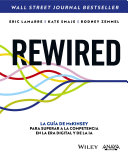

The book delves into how neuroscience can inform our understanding of behavior change. It posits that our brains are not static, but rather malleable and capable of change through neuroplasticity. This idea is crucial for anyone looking to implement lasting changes in their personal or professional life. By understanding how habits are formed and how neural pathways can be rewired, individuals can better equip themselves to break bad habits and foster good ones. The author emphasizes the importance of small, incremental changes, which can lead to significant transformation over time. This approach aligns with the concept of 'micro-habits' where small actions compound to create larger outcomes. The implications for productivity and personal development are profound, as it suggests that anyone can change their behavior with the right strategies and mindset.
Continue readingOne of the key ideas presented in REWIRED is the significant impact of our environment on our behavior. The author argues that our surroundings can either facilitate or hinder our ability to make positive changes. This includes physical spaces, social circles, and even digital environments. By consciously designing our environments to support our goals—such as decluttering workspaces, surrounding ourselves with positive influences, or limiting distractions—we can create a conducive atmosphere for growth and productivity. This idea encourages readers to take control of their surroundings and be mindful of how they affect their actions, ultimately leading to better decision-making and improved outcomes.
Continue readingMindfulness is another central theme in REWIRED. The author discusses how cultivating mindfulness and self-awareness can enhance our ability to make conscious choices rather than reacting impulsively. This practice allows individuals to observe their thoughts and emotions without judgment, leading to greater clarity and focus. By being more aware of our internal states, we can identify triggers that lead to undesirable behaviors and replace them with healthier responses. The book provides practical exercises and techniques for developing mindfulness, emphasizing its role in stress reduction, emotional regulation, and overall well-being. This concept is particularly relevant in today's fast-paced world, where distractions and stressors are abundant.
Continue readingREWIRED emphasizes the importance of effective goal setting and understanding intrinsic versus extrinsic motivation. The author explains that setting specific, measurable, achievable, relevant, and time-bound (SMART) goals can significantly enhance our chances of success. Additionally, the book explores the difference between intrinsic motivation, which comes from within, and extrinsic motivation, which is driven by external rewards. The author argues that intrinsic motivation is more sustainable and leads to greater satisfaction in the long run. By aligning our goals with our values and passions, we can tap into a deeper source of motivation that propels us toward our aspirations. This insight is invaluable for anyone seeking to achieve personal or professional milestones.
Continue readingThe book highlights the importance of community and social support in the process of behavior change. The author suggests that being part of a supportive community can significantly enhance our ability to make lasting changes. This can take the form of accountability partners, support groups, or even online communities that share similar goals. The sense of belonging and shared purpose can motivate individuals to stay committed to their goals, as they draw strength from collective experiences. This idea underscores the social nature of human beings and the impact of relationships on our behavior. It encourages readers to seek out and cultivate connections that foster growth and accountability.
Continue readingREWIRED discusses the dual role of technology in our lives, highlighting how it can be both a distraction and a powerful tool for change. The author advocates for the mindful use of technology, suggesting that it can be harnessed to support our goals rather than hinder them. This includes using apps for habit tracking, online courses for skill development, and digital platforms for community building. However, the book also warns against the pitfalls of technology, such as information overload and constant connectivity, which can detract from our focus and well-being. By being intentional about our technology use, we can leverage its benefits while minimizing its drawbacks.
Continue readingFinally, the book emphasizes the importance of resilience and adaptability in the face of challenges. The author discusses how setbacks and failures are an inevitable part of the change process. Developing resilience allows individuals to bounce back from adversity and maintain their commitment to their goals. The book provides strategies for cultivating resilience, such as reframing negative experiences, practicing self-compassion, and maintaining a growth mindset. This idea is particularly relevant in a rapidly changing world where adaptability is crucial for success. By embracing resilience, readers can navigate obstacles with confidence and continue to pursue their aspirations despite difficulties.
Continue reading